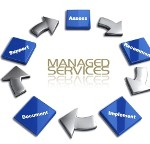Small to medium size businesses are what keep this country moving. Unfortunately, for many of these business owners, budgetary needs force them to make cuts that the mammoth corporations do not have to consider. These budget cuts can often result in reduced security and sub-par IT services that in the long run can end up costing the company even more money. Reacting to; and the recovery from, a security breach or attack always costs more after it has happened than what it would have cost to prevent it.*
This fact has been supported by recent surveys, and may come as a surprise to many small and mid-size companies who are under the false impression that hackers and other security threats target larger corporations. It has been discovered that companies that have less than 500 employees are actually more likely to be at risk of an attack or security breach than a larger corporation. Of course, this becomes a problem when the larger corporation has the resources to maintain higher levels of security at a time when smaller companies are dealing with restricted or; in some cases, frozen IT budgets.
The benefits of hiring a Managed IT Services Provider in preventing attacks and security breaches
With a security breach a real concern for small business owners, many are making the decision to bring on outside providers to address their IT needs. Managed services providers can offer an affordable solution to small business owners who are struggling to manage an internal IT staff. In some cases there isn’t even an IT person on staff, which can be just as costly for the small business when they have to bring in a professional on an as needed basis. Considering the money and time spent recovering from a security attack or breech, more business owners are realizing the cost of not having this level of protection is too high to pay. Here we look at how managed services providers can help business owners level the playing field against those who would infiltrate their security systems.
- Increased knowledge – Managed services providers are in the business of technology. They have trained staff who are able to prevent security breaches and spot any activity that could be perceived as a threat. Moreover, they have the expertise to stop threats and prevent the loss of sensitive and private information that can lead to costly recovery measures.
- Less expensive than in-house IT – Other IT professionals can provide the same security but it will cost much more to the business owner. What many owners are realizing is paying a flat monthly fee for security and other services provided by MSPs is actually much more cost effective than paying an internal IT staff or outsourcing based on incident.
- Proactive is better than reactive – The biggest benefit of having a quality managed services provider in your corner is the fact that you are acting in a proactive manner to ensure all of your systems are managed properly. This is less expensive and less time consuming than waiting for something bad to happen and then reacting.
Any small business can benefit from the security provided by a Managed IT Services provider. They can do so at a fraction of the cost, therefore eliminating the fear and unnecessary cost of trying to recover from a breech in security or attack.
*Source: SPC International Online, Inc.
If you would like to know more, please contact us at 1-800-871-9683 for a free consultation. Also, if you do not have online BDR (backup-disaster-recovery) and anti-virus/malware protection for your business, please give us a call to help you implement the latest systems. Our email address is: markhuffman@creativebusinesstechnologies.com




